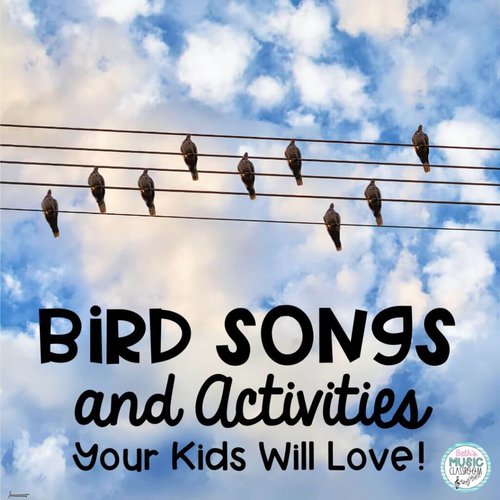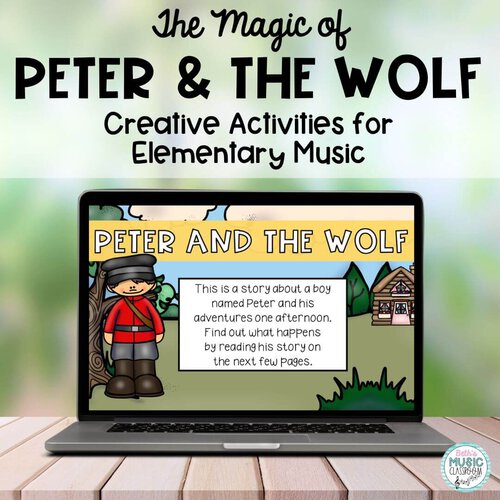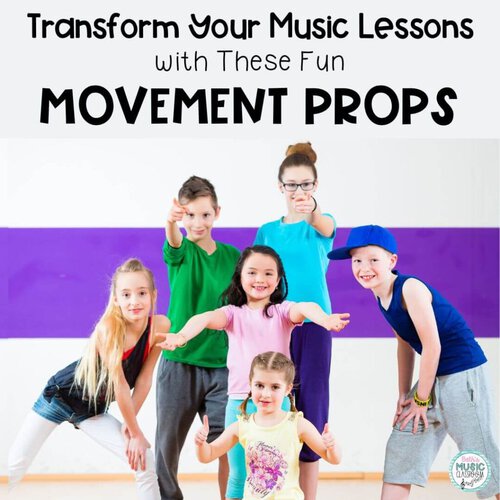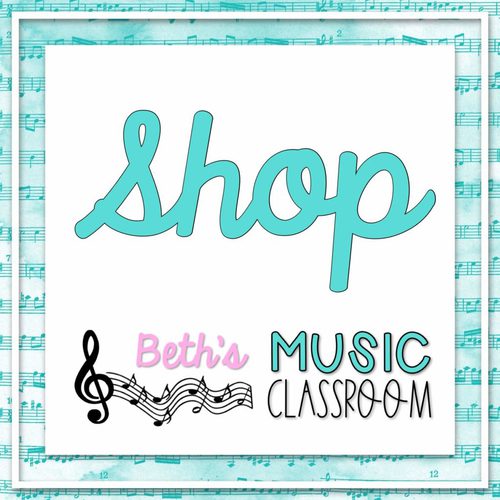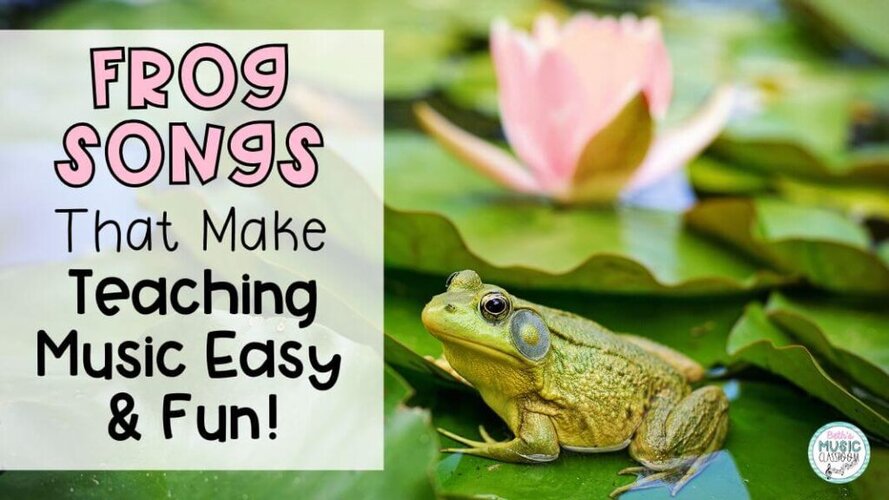
Folk songs about animals are always a hit with children, but there’s something extra fun about frog songs. Maybe it’s the silly sounds, the hopping movements, or just … that it’s frogs. Whatever the reason, frog songs are a great way to get students singing, moving, and making music—especially in spring.
In this post, I’m sharing three folk songs all about frogs that work well for the K–3 classroom. Each one includes a few ideas for how you might use it in your lessons, whether you’re focusing on rhythm, pitch, or just enjoying some playful fun in the music room.
Frog in the Meadow
First, let’s look at “Frog in the Meadow.” This is one of my go-to songs for introducing re. If you didn’t know, there are two different melodic versions of this song. One contains so-mi, and the other also has do-re-mi in the melody. I like using the do-re-mi version (Sail Away: 155 American Folk Songs to Sing, Read, and Play—affiliate link, you pay the same amount).
Here’s a great version of this song from John Feierabend and Jill Trinka’s collection.
Teach “Re”
“Frog in the Meadow” is a short, catchy song, full of opportunities for spring and frog fun. I use the song to teach re to my 2nd and 3rd graders and to just have fun with my K-1st graders. Think of any visuals or props you have available to use. For example, you can cut large lily pads from green construction paper to show the melodic contour of mi-re-do. If you have staff boards for students, cut smaller lily pads and have them place on the staff to notate each phrase. Also, I love having my students hop around on the large staff on our music carpet. It’s a very simple melody with only three notes, so they can easily pretend they are playing the notes as they are singing. For younger students, I love pulling out my frog guiro and puppet.
Play a Circle Game
After students have learned the song very well, it’s time for a game. There are several different games and activities you can add to this frog song.
Here’s a very active game your students will love, plus, a video below to help you see it in action:
- Students stand in a circle with one student (the frog) in the middle with their eyes closed.
- While singing the song, the frog spins around the circle pointing to students.
- At the end of the song, the frog waves their hand, “cutting” between the person they pointed to and their neighbor.
- Those 2 students run in opposite directions around the outside of the circle, racing to get back to tap the “frog’s” hands. Whoever does not win is the new “frog” in the middle.
Create or Improvise
‘Also, I enjoy using an instrument activity for younger students. Everyone sits in a circle, singing the song with a drum and a frog guiro in the center. Two students at a time take turns being in the middle (“meadow”). One plays the steady beat on the drum while the class sings; the other student improvises a rhythm on the frog guiro after the song is over. Then you can just choose two new students or use a passing game during the song to select the new group.
You could try having your students create their own lyrics to the melody. With younger children, it could be as simple as replacing the word “meadow” with a new place—”where did the frog go this time?” Try having your frog on a school bus or rollercoaster, in the rain, ocean, or garden. Sing each new verse, adding appropriate motions that match the new lyrics.
Movement
Finally, you can add some extra movement to this frog song. Here’s a second verse that I wrote and turned into a fun, active listening game for K-2nd graders:
Frog in the meadow, can’t get him out.
Take a little stick and stir him about.
But if you stir him, he might just leap.
Or maybe yet, he’s still sound asleep.
For this game, the students (“frogs”) sing verse one, plus the new verse. Then they listen to the piano (or music being played) to determine if they should “sleep” or “leap.” If they hear “sleep” music (peaceful, legato, and quiet), students sit as still as a frog hiding out in the water, waiting to get a fly. If they hear “leap” music (happy, staccato, excited, loud), students hop around the room until the music stops. After a few rounds, alternate the game with the song.
The Little Green Frog
“The Little Green Frog” is a timeless children’s classic. With its silly lyrics and fun motions, it’s a favorite at camps, in classrooms, and pretty much anywhere kids are ready to get a little goofy.
Just like other frog songs, there are lots of different versions to this one as well. Some start with the lyrics “Mmm-ah” or “Gung-gung,” and others use the word “Galump” to match the frog’s silly hopping motion. In some versions, verse 1 finishes with the same lyrics as the beginning, but some say “blink-blink-blink.” There’s also variations with adding an even sillier part with lyrics for the frogs singing “la-dee-dah-dee-dah” or “sha-dee-dah-dee-dah.” No matter which words you use, the playfulness of the song stays the same—and part of the fun is making it exciting for your students. So let’s jump into some activities kids will love.
Adding Motions
When you’re first teaching the melody of this song, encourage students to listen for big leaps in the melody or repeated notes. I use motions that show the melodic contour. Students start by squatting down on “ga-” and then jump up on “lump.” Then (using a song version that has the melody go up) students raise their hands up high on the words “one day.” Both of these will help later in adding melodic instruments to the song.
Here’s the body percussion that I use and later transfer it to instruments:
- “Ga-” or “Gung” (first one): pat
- “-lump” or “gung” (second one): clap
- “went the little green frog”: 2 hands rolling in circle in front of chest
- “one day”: 2 hands big wave together above head
- “his eyes”: 2 snaps above head
Using Props
Bringing in a visual for any of the frog songs, like a puppet or stuffed animal, is great to grasp your students’ attention. If a student is unable to perform the hopping motions, it’s good to have an alternative for them to still participate. Here are a few frog visuals I’ve used and loved:
- Frog puppet from Folkmanis
- Mini Frogs with stretchy tongues
- Mini plastic frogs for staff notation
- Make your own paper frog with tongue
Adding Instruments
Adding instruments is of course a favorite during music class. For this frog song, I have two different instrument activities that I use with different grade levels. With Kindergarten and 1st graders, I have them play boomwhackers and the matching colored rainbow glockenspiels. Also, we add in other non-pitched percussion to fill the rest of the song. I basically have students transfer each of the body percussion or movements (shown above) to a specific instrument or instruments. Here’s what I use:
- “Ga-” or “Gung” (first one): pat → low sol on boomwhackers and/or glockenspiels
- “-lump” or “gung” (second one): clap → do on boomwhackers or glockenspiels
- “went the little green frog”: 2 hands rolling in circle in front of chest → maracas and/or frog rasp
- “one day”: 2 hands big wave together above head → high sol on boomwhackers and/or glockenspiels
- “his eyes”: 2 snaps above head → triangle and/or castanets
Now with 2nd and 3rd graders, I use an Orff arrangement with several pitched and non-pitched instruments to accompany the song. First, each instrument group practices their part together. Next, all the rhythmic instruments play together, and the melodic instruments practice together. Finally, they’re ready to add it all to the song. After a bit of practice, they sound great! This frog song even works well for a mini performance, spring concert, or an observation. Grab the same resource I use with my students right here.
On a Log Mister Frog
Finally, let’s look at the last of these three frog songs. This one’s not as well-known, but it’s a great one for young students and for incorporating movement and improvisation. You can introduce it just as a story with just lyrics and rhythm at first. Next, ask students what Mister Frog might sing while he’s on his log. Also, what do you think he will see as he sits on his log? Get students thinking about the story and using their imaginations.
Practicing Reading Melodies
Then, I teach the song using melodic icons for this sol-mi-la-do melody. If students have not learned do yet, it’s easy to just teach the melody of the first 3 phrases and not the repeated do at the end. Before reading the solfa names for the song, you can use motions to show the contour of the song. For example, any notes on sol, you would tap your shoulders, la on your head, and mi on your waist. It’s a great song to introduce the note do (pat on your knees) after students are confident with so-la-mi melodies.
Adding New Lyrics
Once students can sing the song, we change it up a bit. This frog song actually has several other verses with different animals. You can find a recording of the full version here. Students can add mister snake, bee, etc. to the song or come up with their verses. For example, here’s my cat verse that I add:
On a mat,
Missus cat,
Stretched and yawned, imagine that!
Meow, meow, meow, meow.
Another way to add new lyrics is to have your students come up with their own place, animal, or song/sound. Students could decide where mister frog is going next, changing the place—”on a boat,” “in a house,” or “at the park.” Another way to try is to change just the animal.
If you’d like to get students practicing melodic skills, try only changing the last phrase. Encourage them to improvise something new for the frog to sing. For example, instead of “do-do-do-do,” students may play/sing “mi-re-do-do” or “so-la-so-mi.”
Adding Instruments
Using your students’ improvised lyrics, you can add different instruments to represent each sound. Use a frog guiro for the “glumph” and choose other classroom instruments that may match each animal sound.
This song is also a great one for adding xylophones. With one chord played as a bordun throughout the song, even young children can play along. If your students are ready, try a broken bordun to mimic the frog’s hopping motion. You can also then add students’ improvised melodies on glockenspiels to the end of each verse.
For rhythmic instruments, I love using the round tone blocks or guiros since they look like a log. Have students scrape the side to the steady beat of the song. Choose a few other instruments to play simple patterns of ta and ti-ti or frog and ribbit. Just decide whether to let your students decide or you’ll assign each part.
Movement
Finally, get your students moving with a simple and fun circle dance to this frog song. I just love this adorable version for each of the verses to this song. This dance would be great for K-2nd graders.
Why Frog Songs Work
Frog songs are playful, easy to teach, and full of musical possibilities. Plus, they are perfect for a fun spring lesson, when students are wiggly and ready for something a little more imaginative. These songs bring energy and structure at the same time—and they make musical skills stick. You don’t need any fancy materials to get started, and you can easily add each of these frog songs to your lessons today. Just decide on activities from this list that will work based on your students’ age and experience level.

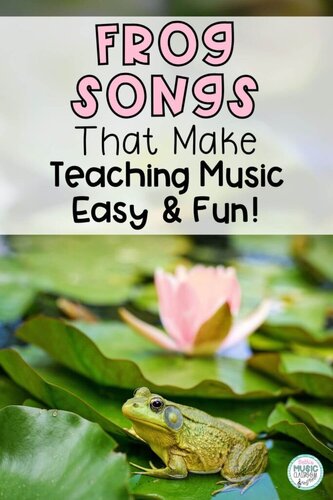
Here’s some other posts you may like.
